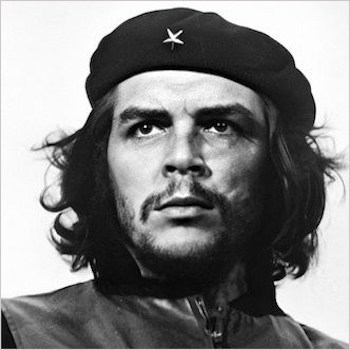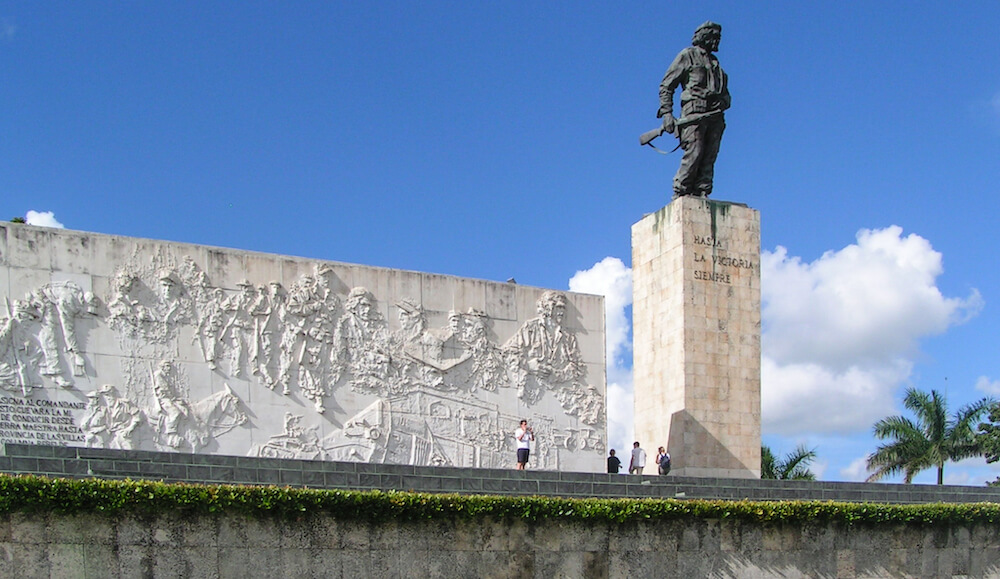21st-Century Legacy: Che Guevara's Ongoing Influence

It takes a very long time to get to know Che Guevara as a man and even longer to know him as an revolutionist. Although medical doctor, political revolutionary and world ambassador Ernesto "Che" Guevara died many decades ago, his legacy remains relevant in a number of significant ways. Although he fell into disfavor as Fidel Castro's right-hand man due to his penchant for speaking the truth as he saw it and was exiled in Bolivia during his final days, the image of Che Guevara and everything he stood for remains emblazoned on the minds of fans and foes alike in the contemporary landscape.
Monuments to Che
After Che's demise in 1967, the Cuban government cleaned the tarnish from his reputation and in 1997, it unveiled the Che Guevara Mausoleum and Monument in Santa Clara, Cuba. It not only contains the remains of Guevara and some of his fellow Bolivian revolutionaries, but also features a parade ground, a larger-than-life statue of the Che, and a bas relief sculpture depicting scenes from his life story. Visitors to Havana can also view a huge statue of the revolutionary in the city's Revolution Plaza, as well as billboards with his likeness and quotations nationwide.
Statues of the Argentina-born Guevara memorialize his historic contributions throughout the world. One of these is located in New York City's Central Park, despite Guevara's stated belief that the U.S. was the nemesis of humanity. Another Che likeness watches over La Paz, Mexico while countries as far-ranging as Austria and Ukraine host Che memorials. Statues in Bolivia and in his birthplace, Rosario, Argentina, pay homage to his direct contributions to their societies. However substantial these objective reminders of Che may be however, the inspirational legacy of his biography and philosophy have proven to be even more powerful in the culture of the 21st century.
Once Fidel Castro was installed as the new Cuban leader, Guevara again set the example as an ambassador, working to reduce the country's reliance on export sales to the United States. As Castro's emissary, Che took on this new role with as much determination as he had leveraged as a guerilla fighter. His consistent goal was to help mold Cuba into a model socialist state, and he worked tirelessly to accomplish it. His determination and work ethic continues to serve as a positive example to people 50 years after his death, as the scores of relatively recent publications on Guevara will attest.

Guevara's Image
Always a polarizing figure in life, Guevara's enduring image continues to divide people of different ideologies and beliefs. As an archetype, Guevara symbolizes the revolutionary spirit, and if a single photo could communicate that symbolism, it would be "Guerrillero Heroico," which the Cuban newspaper photographer Alberto Korda snapped in 1960 at a state funeral in Havana. The iconic photo, which captures Guevara in his signature beret with an angry yet visionary look in his eyes, is the single most widely distributed image of the man and has become rooted in popular culture.
Italian publisher Giangiacomo Feltrinelli was the first to distribute Che's photograph to the public during efforts to raise awareness about Bolivia's plight in 1967. Upon returning from the war zone where with the revolutionary's diary in hand, he published Che's writings along with the Guerrillero Heroico photograph. He released the publication worldwide after Che was executed, and disseminated a number of posters in Italy bearing the same image. Shortly thereafter, Guerrillero Heroico began to appear at more and more protest rallies in Europe. In 1968, the somewhat stylized image appeared in subways throughout New York City on ads for the Evergreen Review. Guevara was well on his way to becoming a cultural icon.
Che in Pop Culture
In the 21st century, Che-themed art exhibits in many major world capitals testify that the revolutionary still captures the imaginations of people everywhere. London, New York City, Milan, Amsterdam, Miami, Vienna, Amsterdam, Moscow, Istanbul and Havana are among the cities that hosted such events in the 2000s. Additionally, Che's image continues to appear on all sorts of souvenirs, commodities, advertisements and clothing in mainstream markets.
Fortunately, the man who fought against the domination of U.S. capitalist concerns in Central and South America did not live to see his image adopted in the 21st century for commercial purposes. Capitalist corporations have used Che's face to market everything from perfume to running shoes. The long list of brands that have co-opted the Guevara cachet include Adidas, automaker Dacia, Smirnoff, Fischer skis, Taco Bell, Bobblehead LLC and Tartan Army. Club Che restaurants in Russia and a Che Café in San Diego, Cal., are a few of the hospitality establishments profiting from the revolutionary icon's legacy.
In addition, a number of actors have portrayed Guevara in various films and shows. From Omar Sharif in the 1968 movie, "Che!," to Antonio Banderas in the 1998 film, "Evita," the idealized image of the revolutionary has become increasing embedded in American culture. His image has graced the covers of Time and Rolling Stone magazines. The Che Guevara influence is also apparent on television, in the theater and in the music industry.
Che's Philosophy
In the uncertain political climate of post-Fidel Castro Cuba, the influence of Guevara's ideology is far less powerful than it is outside his adopted homeland, not only as an image of the revolutionary spirit but also as a role model for proponents of the New Left. He saw Marxism as the guiding principle for freeing Latin America from the oppression of such capitalists as the United Fruit Company, a U.S.-based corporation which monopolized the banana industry in Central and South America in the early 20th century.
Additionally, the insights Che developed during the journeys he took in his college years inspire people of diverse political leanings. These were no vacation trips to resort areas. They were tours of Argentina and other South American countries among poverty and disease-ridden communities where the medical student helped out as needed and formed a deep compassion for the plight of the poor all around him. What sets Che apart from most people with similar experiences is that he made good on his vow to do something to improve the lives of the people he met, and he dedicated his future to that cause. His detractors would say the violent course of action he would choose to try and fulfill his mission was an unworthy one, but Guevara saw it as his only choice.
He wrote the book Guerrilla Warfare, after the success of the Cuban revolution, but it was not published until just after his death. In this guidebook for revolutionaries, Guevara discusses his foco approach, which relies on small groups of guerilla insurgents that center a society's drive for change and inspire popular support for more widespread military action. Subsequent insurgencies in South and Central American nations based their reform movements on aspects of "Guerilla Warfare" and Guevarism, Che's theory of communist revolution and his military strategies.
Additionally, powerful groups and leaders, ranging from the Sandinistas in Nicaragua, who wore Guevara T-shirts upon their return to power in 2006, to Hugo Chavez of Venezuela and Evo Morales of Bolivia champion the Guevara legacy in the 21st century.
Guevara's Descendants
During his lifetime, the Argentinian fathered five children: Hilda, Aleida, Camilo, Celia and Ernesto. Hilda Beatriz Guevara Gadea was his oldest child, and she was born in 1956 to Che and his first wife, Hilda Gadea Acosta. She was just 11 years old when her father died, but she remembered him and Castro, whom she thought of as "Uncle Fidel," until her death at the age of 39.
While all the Guevara offspring have been significantly influenced by the examples set by their father, perhaps his second oldest daughter has been the most influential in her own right, keeping Che's Marxist philosophy and dreams of a better world alive as she creates her own legacy. Aleida Guevara March, born in 1960, is Che's oldest child from his second marriage to Aleida March. She followed her father's professional example in pursuing a medical degree. She shares his dedication to the Marxist philosophy.
Currently living in Havana, Aleida has worked as a lead in pediatric teams in Angola, Ecuador, Venezuela and Nicaragua, and is an outspoken human rights advocate. She finds Che's diaries and writings to be a source of inspiration as she continues to build upon the groundwork he laid in Cuba as a revolutionary and second-in-command to Fidel Castro.
The Enduring Qualities of Charisma and Character
If there is one hero in Latin America's struggle for liberation - stretching from Bolívar's time until our own who has attracted young people from Latin America and from all over the world, that hero is Ernesto Che Guevara. And though since his death he has become a modern myth, he has not yet been stripped of his youthful vitality. To the contrary, his mythic status has only served to heighten his youthfulness which, together with his daring and his purity, seem to constitute the secret essence of his charisma. The legacy of Che Guevara is so ubiquitous in contemporary society that it would be nearly impossible to be unaware of the man, his principles and/or his history. Love him or hate him, Che's impact on the world of his era as well as times to come has made an imprint that spans contemporary culture on a number of levels. While his children and grandchildren are the living embodiments of his legacy, his influence on the generations following his death is an ongoing testament to his unique charisma and strength of character.
